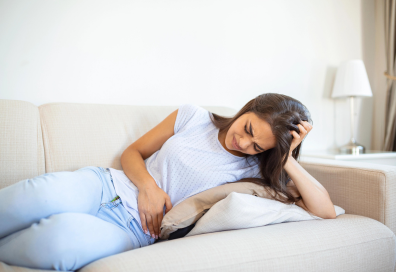
Empowering Endometriosis Self-Care with Castor Oil Packs
Written by: Heather Tanti R.P.N (non-practicing)
Medically reviewed by: Victoria Williams R.H.N.
Est. reading time: 12 minutes
In the quiet corners of countless lives, a silent struggle unfolds, one that often goes unnoticed—the battle against endometriosis. It’s the kind of pain that isn’t just physical; it’s emotional, mental, and sometimes even spiritual. It’s the ache that keeps you up at night, the discomfort that impacts your every movement, and the invisible weight that seems to crush your spirit on the toughest days.
Living with endometriosis isn’t just about enduring the physical symptoms; it’s about navigating a maze of uncertainty, frustration, and often, loneliness. It’s about struggling to explain to others why simple tasks sometimes feel like climbing mountains. It’s about battling against the stigma that surrounds “invisible illnesses” and the disbelief that often greets our pain.
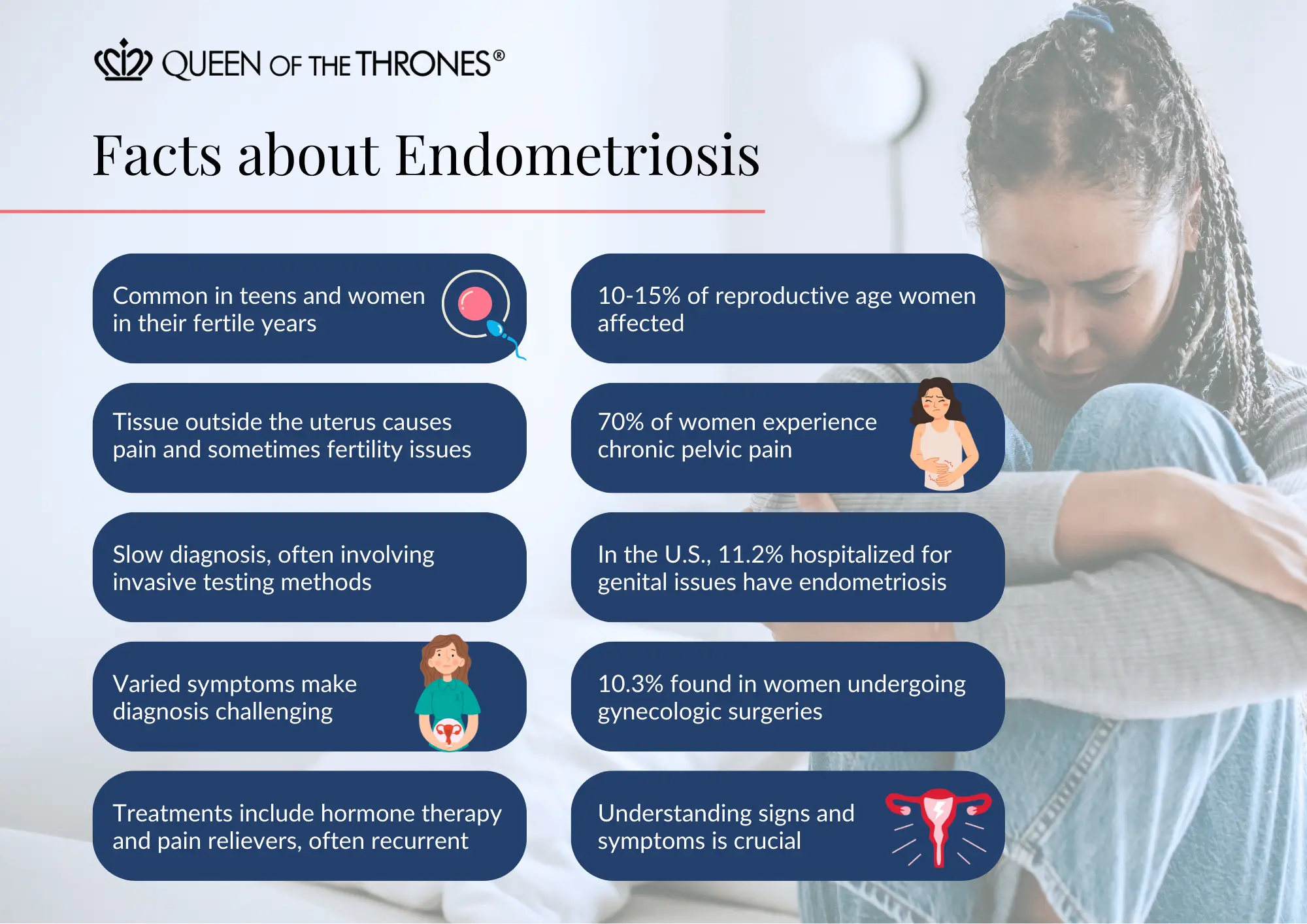
Yet, amidst the struggles and the tears, there’s a resilience that burns bright within each of us. It’s the resilience that gets us out of bed on the darkest days, that pushes us to seek answers even when the medical system fails us, and that reminds us that we are more than our pain.
Beyond the medical approach lies a natural self-care support; a comforting approach to the struggles faced with endometriosis– Castor Oil Packs.
Journey with us as we explore the ups and downs of endometriosis, and how the nurturing touch of Castor Oil Packs may help support the symptoms that often weigh you down.
What is endometriosis?
Endometriosis is a condition that typically affects teenagers and women of reproductive age. It involves the presence of endometrial tissue outside the uterus, often leading to persistent pelvic pain and fertility problems.
Diagnosing endometriosis can be slow because there’s no clear and easy way to confirm it without invasive methods. Symptoms vary, making it tough to pinpoint. Treatment usually involves using hormones and pain relievers, but they don’t always work well since endometriosis often comes back.1
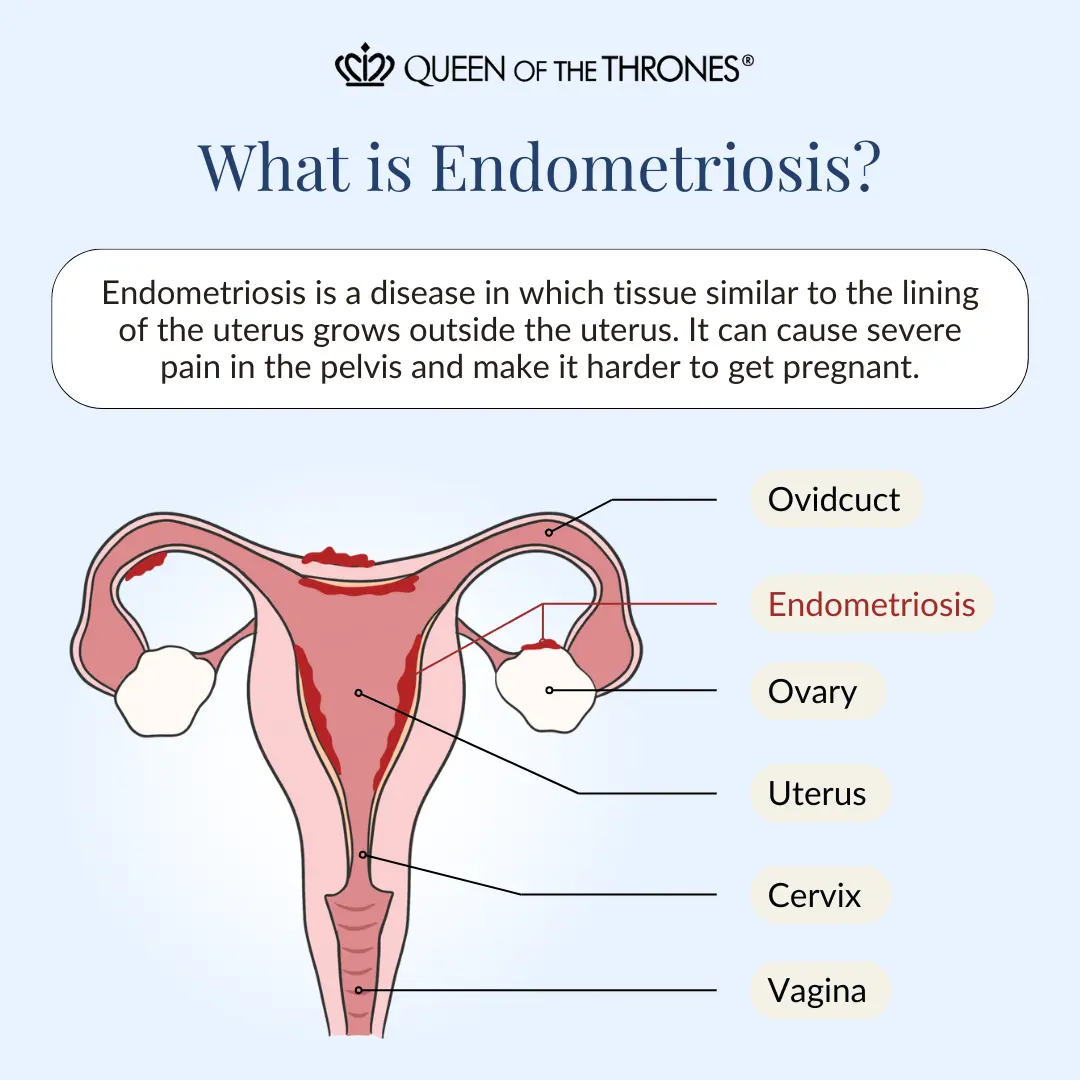
In the U.S., a recent survey found that 11.2% of women aged 18 to 45 hospitalized for issues related to the genital and urinary system were diagnosed with endometriosis. Additionally, about 10.3% of women who had gynecologic surgeries were found to have endometriosis.2
Now that we understand what endometriosis is and how common it is among women, let’s dive deeper into the signs and symptoms that often accompany this complex condition.
What is thoracic endometriosis?
It includes four specific clinical conditions:
- Catamenial pneumothorax
- Catamenial hemothorax
- Hemoptysis
- Pulmonary nodules
This syndrome is rare and complex, and clinicians frequently face challenges in diagnosing it, leading to delayed or overlooked cases. Such delays can contribute to recurrent hospitalizations and other complications.3
Symptoms of endometriosis?
As we peel back the layers of endometriosis, we uncover not just a medical diagnosis, but a relentless storm of symptoms that can wreak havoc on every aspect of life. It’s like being caught in a whirlwind of pain, uncertainty, and frustration, where every day feels like a battle against your own body.
From the relentless pelvic pain that feels like a dagger twisting in your gut to the fatigue that weighs you down like an anchor, the symptoms of endometriosis are more than just physical; they’re a constant reminder of the silent struggle raging within.
But it’s not just the pain that defines endometriosis; it’s the invisible symptoms too—the anxiety that clenches your chest, the depression that clouds your mind, and the isolation that wraps around you like a suffocating blanket. It’s the endless doctor’s appointments, the countless medications, and the never-ending search for relief that can leave you feeling lost and alone.
Endometriosis symptoms can be grouped into three categories:
1. Menstrual dysfunction
2. Ovulatory dysfunction
3. Reproductive dysfunction
Problems with periods, like pelvic pain, painful periods, and pain during sex, are common signs of menstrual dysfunction. In younger patients with these issues, endometriosis is often found to be the cause, especially if the doctor sees unusual lesions.
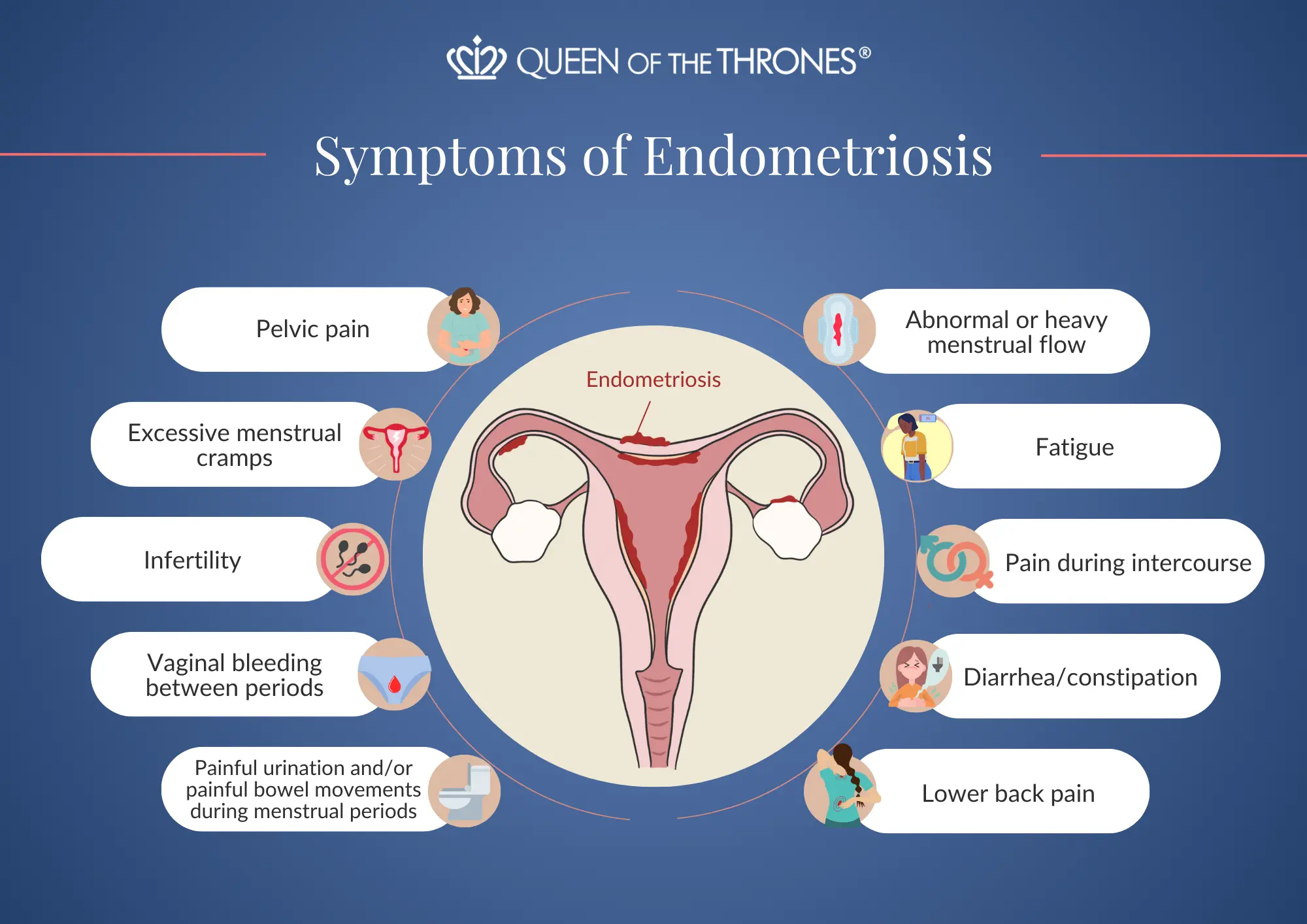
But endometriosis symptoms often go beyond the pelvic area, and can impact your entire body, including back pain, and constant lower abdominal pain often connected to bladder filling and going to the bathroom.5
The relentless struggles with endometriosis symptoms can profoundly impact every facet of one’s life. The constant pain, ranging from menstrual discomfort to persistent abdominal and back pain, becomes an unwelcome companion in daily activities. Intimate moments turn into sources of anxiety and discomfort, and even routine activities like using the bathroom become painful episodes.
The irregular menstrual cycles and fertility challenges add emotional strain, while chronic fatigue casts a heavy shadow on daily energy levels.
If you’re nodding your head relating to these symptoms, you’re not alone
Stages of endometriosis
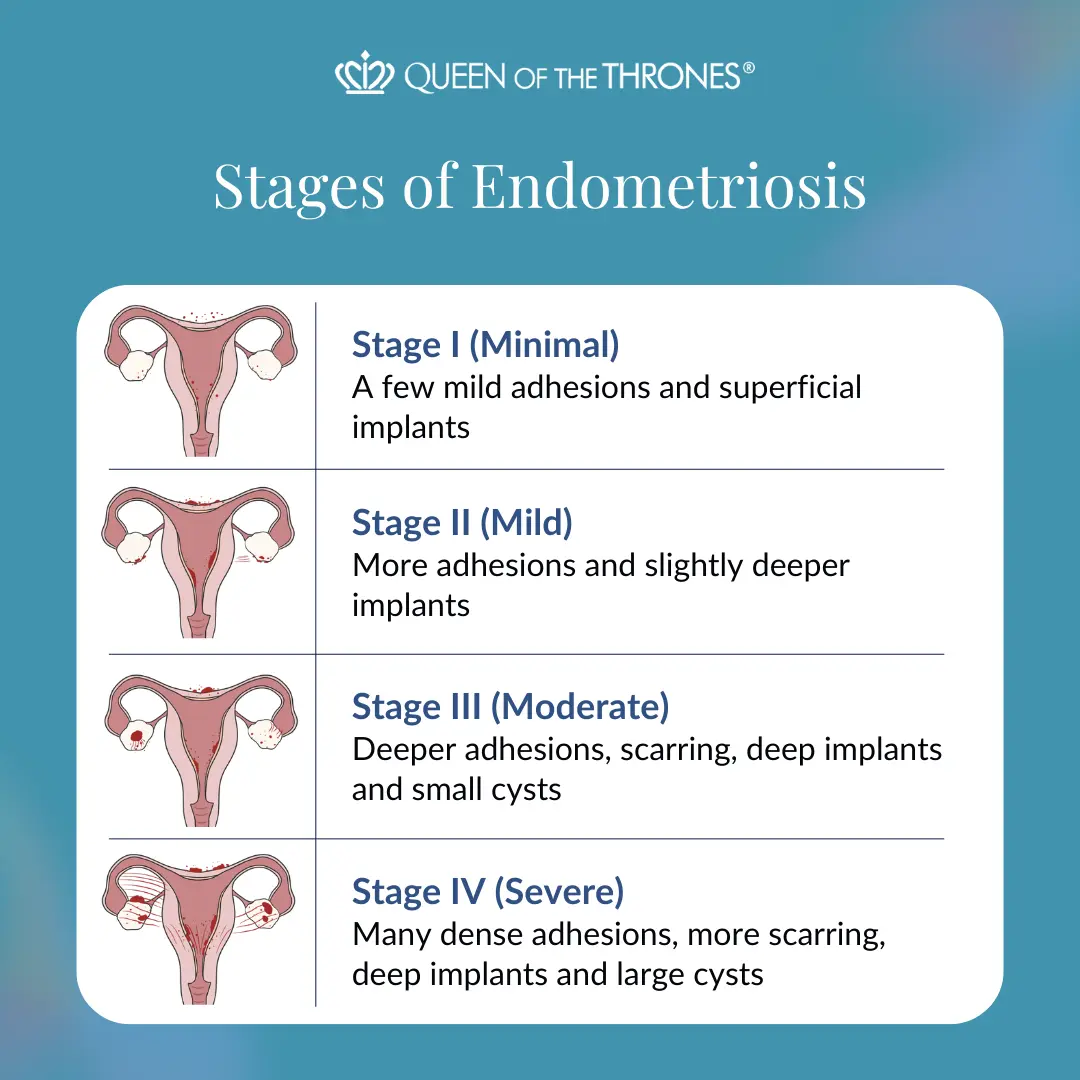
The American Fertility Society uses a scoring system to classify endometriosis into four stages, ranging from Stage I (minimal) to Stage IV (severe). This classification is determined by the location and size of the lesions observed during surgical procedures.6
Endometriosis diagnosis
Using less invasive tests like imaging, genetic tests, biomarkers, or miRNAs could be the key to making the diagnosis of endometriosis less intrusive. Research suggests that different methods may contribute differently to the diagnosis, depending on the type of endometriosis. For instance, transvaginal ultrasound is good at detecting endometriomas but not superficial/peritoneal endometriosis.
While various non-invasive tests show promise in diagnosing this complex condition, further research is needed before they become part of routine clinical care.7
So you see, getting to the bottom of endometriosis often feels like putting together a puzzle, except that puzzle can look different for everyone.
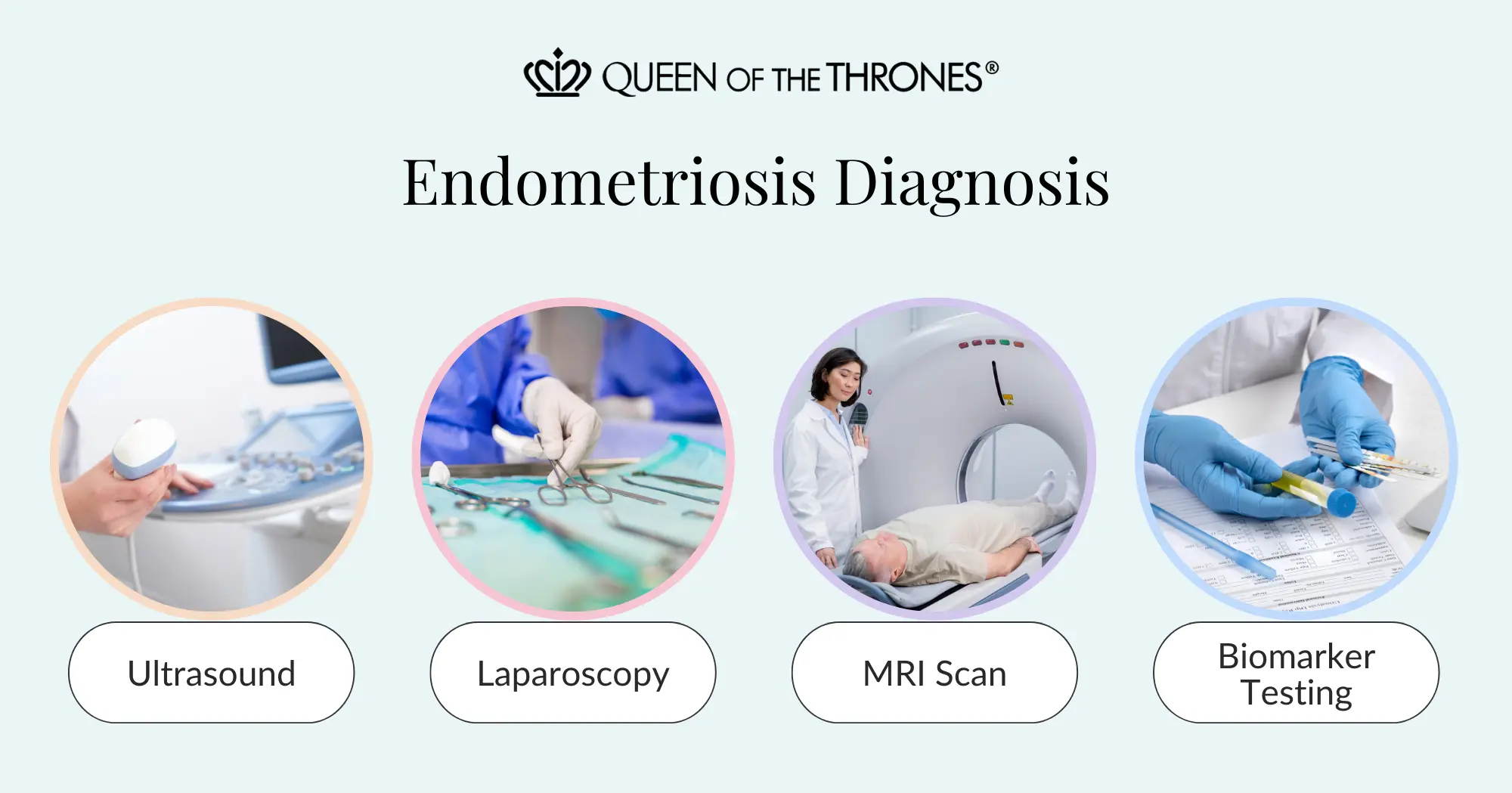
Endometriosis and treatment
When it comes to dealing with endometriosis, the current medical game plan is more about managing the condition than waving a magic cure wand.
The good news is, many women do find relief and better control of their symptoms with medical treatments. But here’s the catch – these treatments might bring some not-so-fun side effects and can be a bit heavy on the wallet. Plus, once you hit pause on the meds, symptoms often make a comeback.
So, it’s a bit like a balancing act between finding relief and dealing with the trade-offs of the treatment journey.8
Some of these medical treatment approaches include:
- Hormone therapy: One of the most effective ways to manage pain from endometriosis is often through hormonal drugs, regardless of the type of endometriosis (whether it’s in the ovaries, deep, or superficial). Medications like gonadotropin-releasing hormone analogs and oral antagonists work by causing a kind of induced menopause, which helps lessen painful periods (dysmenorrhea) and other pain symptoms.9
- Pain medications: As per the World Health Organization (WHO) guidelines, non-steroidal anti-inflammatory drugs (NSAIDs) are included in the initial pain management approach, and often include Ibuprofen, naproxen, or metamizole as suitable pain relievers.10
- Surgical treatments: Surgical treatment for endometriosis aims to completely remove all lesions in a single procedure, offering promising long-term results for pelvic pain, recurrence, and fertility, while preserving organ functionality. The decision between surgery and medical therapy depends on factors like pregnancy plans, treatment effectiveness, potential complications, pain type and intensity, and the location/severity of the disease.11
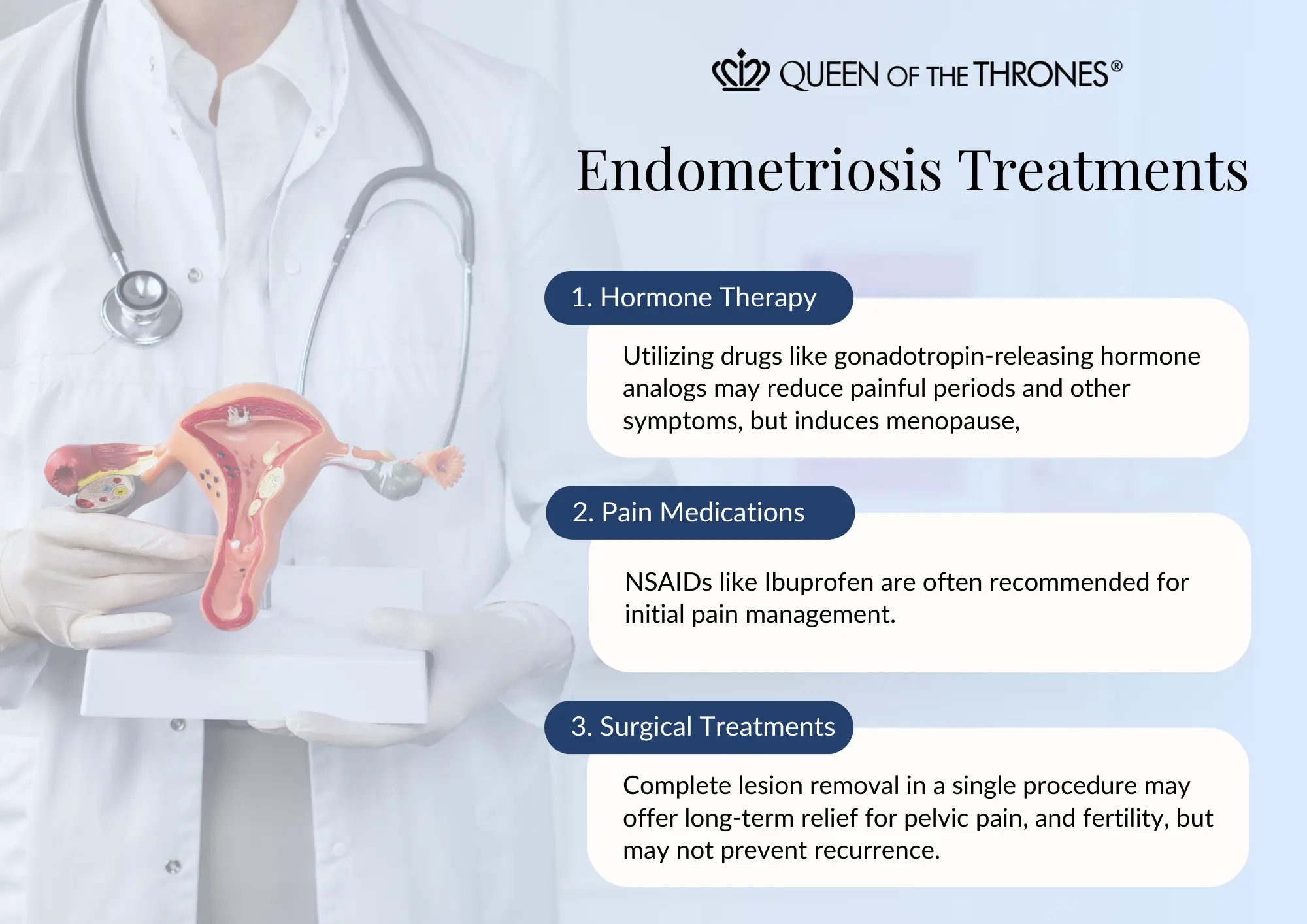
While the above medical treatments may bring relief in the battle with endometriosis, what about natural ways to treat endometriosis?
Natural help for endometriosis
Complementary and alternative medicine treatments include various options like herbal remedies, acupuncture, microwave therapy, and Chinese herb enemas. These methods are believed to help ease period pain, shrink masses in the pelvic area, and improve the chances of getting pregnant, all with fewer side effects compared to hormonal or surgical treatments.12
Beyond the medicinal approach lies lifestyle approaches to supporting endometriosis symptoms, including dietary supplements.
Dietary supplements like vitamin D, zinc, magnesium, omega 3, propolis, quercetin, curcumin, N-acetylcysteine, probiotics, resveratrol, alpha lipoic acid, vitamin C, vitamin E, selenium and epigallocatechin-3-gallate (EGCg), are thought to have properties that can help reduce inflammation, fight oxidation, slow cell growth, and support the immune system.13
So, what exactly is a good diet when it comes to endometriosis support? Best practices involve:
- Following a nutrient-rich diet: Eating a diet of healthy fats, hearty proteins, and heaps of vegetables that are high in micronutrients and fiber may help reduce inflammation in the body.14
- Adding in anti-inflammatory herbs and spices: Spices and herbs like turmeric, ginger, garlic, cinnamon, cacao, dark chocolate, chamomile, mint, and others are rich in anti-inflammatory properties. They help alleviate pain and symptoms linked with endometriosis.15
- Avoiding caffeine, sugar and gluten: Excessive intake of these substances may influence blood sugar levels, potentially causing hormonal imbalances. Caffeine can affect your liver function, impacting the body’s natural detoxification process and contributing to estrogen buildup, potentially worsening symptoms.16
4. Supporting your gut health: Taking steps to nurture your gut, such as incorporating anti-inflammatory foods (especially cruciferous vegetables, known for aiding in the removal of excess estrogen that may disrupt hormones and worsen symptoms), including probiotics in your diet, and steering clear of inflammatory foods and triggers, can help contribute to managing endometriosis.17
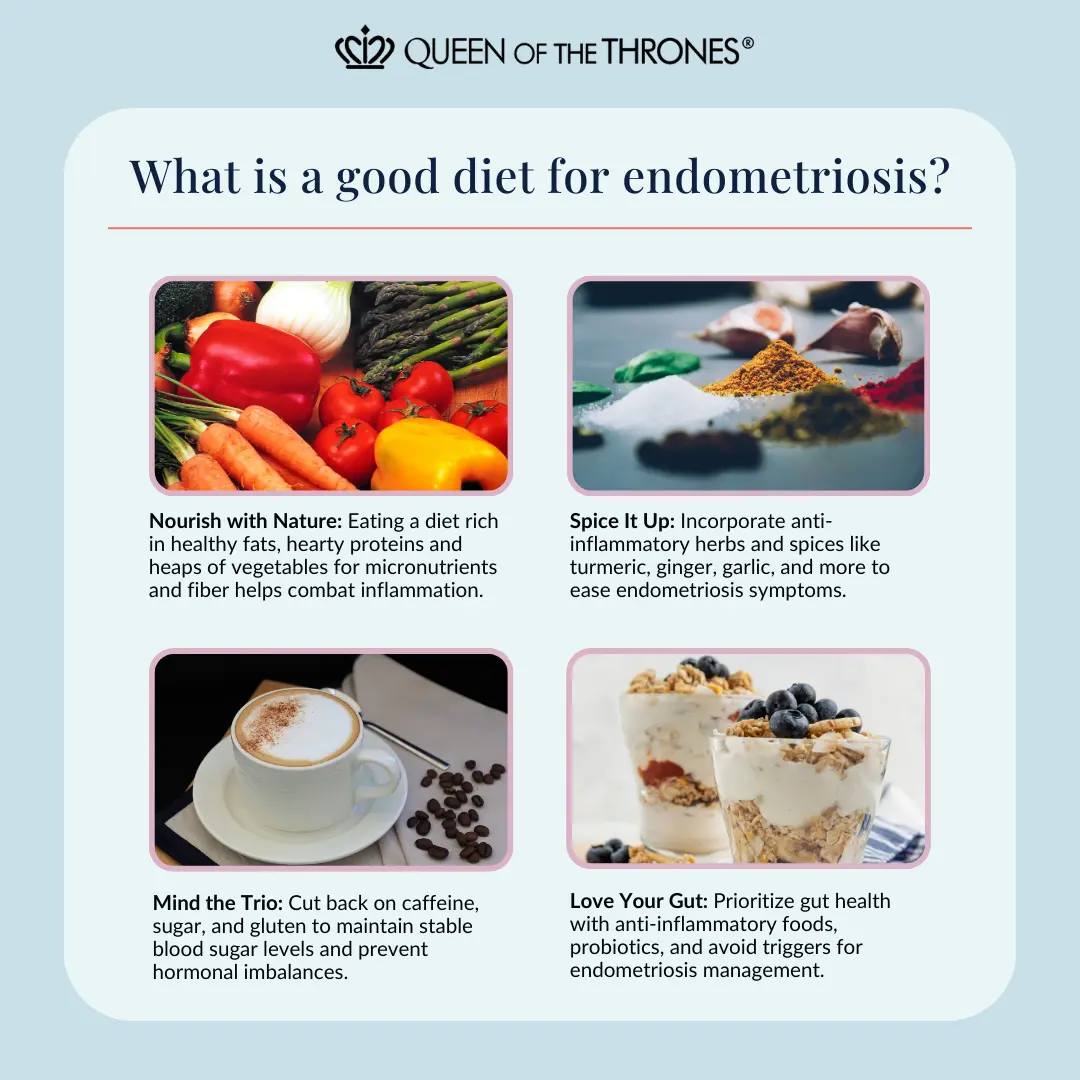
Here’s a lunch/dinner recipe idea to get you started!
Ingredients:
- 1 cup quinoa (uncooked)
- 2 cups mixed vegetables (broccoli, bell peppers, carrots, spinach)
- 1 tablespoon olive oil
- 2 cloves garlic, minced
- 1 teaspoon ginger, grated
- 1 tablespoon tamari
- 1 teaspoon sesame oil
- 1 tablespoon rice vinegar
- 1 teaspoon maple syrup or honey
- 1 tablespoon sesame seeds (optional)
- Fresh cilantro for garnish
Instructions:
- Cook quinoa according to package instructions.
- In a large pan, heat olive oil over medium heat. Add minced garlic and grated ginger, sautéing for 1-2 minutes until fragrant.
- Add mixed vegetables to the pan and stir-fry until they are tender yet crisp.
- In a small bowl, whisk together tamari (or soy sauce), sesame oil, rice vinegar, and maple syrup (or honey).
- Pour the sauce over the vegetables, stirring to coat evenly. Cook for an additional 2-3 minutes.
- Add cooked quinoa to the pan, mixing well with the vegetables and sauce.
- Sprinkle sesame seeds over the stir-fry for added crunch (optional).
- Garnish with fresh cilantro and serve warm.
This quinoa and vegetable stir-fry is not only delicious but also incorporates anti-inflammatory foods, supporting your journey in managing endometriosis.
Castor Oil Packs and endometriosis
Now that we’ve touched on the medical and alternative approaches to symptom support, let’s explore endometriosis self-care with Castor Oil Packs as a natural approach to your wellness.
Castor Oil Packs—a natural remedy with a rich history dating back centuries.
Traditionally, using Castor Oil Packs involved a messy and somewhat complex process. However, modern advancements have transformed this ancient practice into a convenient and user-friendly experience.
Queen of the Thrones® Castor Oil Packs have been designed to support your self-care and wellness with ease and simplicity. So, let’s explore the benefits of Castor Oil Packs and discover how they can help enhance your well-being and support your self-care with endometriosis.
When it comes to naturally supporting your body through the ups and downs of endometriosis, Queen of the Thrones® offers a wide range of Castor Oil Packs to bring you the self-care you deserve.
Queen of the Thrones® Pelvis & Hips Castor Oil Pack
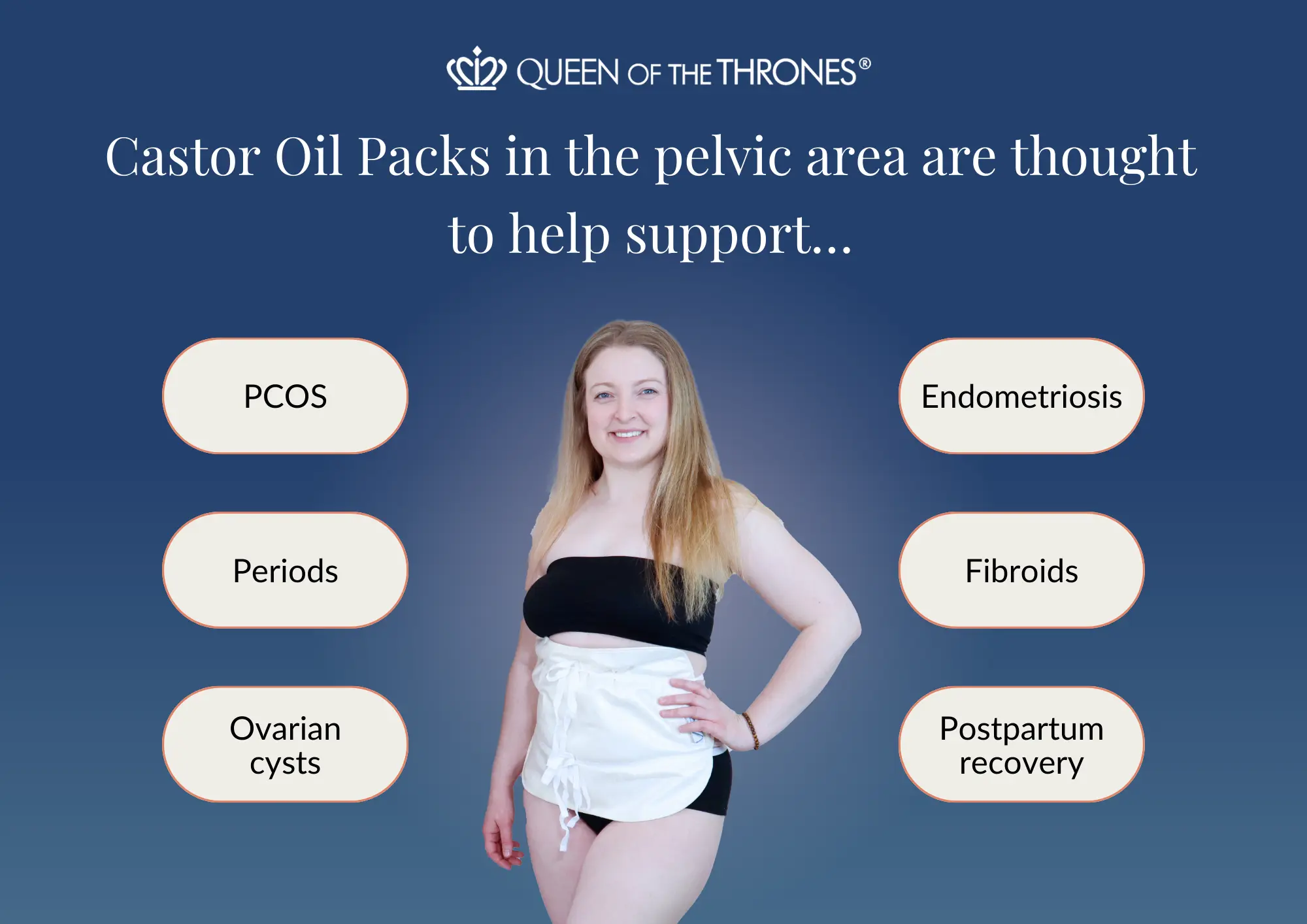
The pain, cramping and inflammation associated with endometriosis can really impact the quality of life women experience, agreed? Besides pain relievers like naproxen, ibuprofen etc. a naturally comforting approach can be used with the Queen of the Thrones® Pelvis & Hips Castor Oil Pack.
This self-care gem is like a warm, comforting hug for your pelvic area, and feels like a cozy weighted blanket.
The best part? When combined with organic Golden Castor Oil, you’re creating a self-care practice that goes beyond the surface, bringing you the benefits of Castor Oil and gentle compression from your pack.
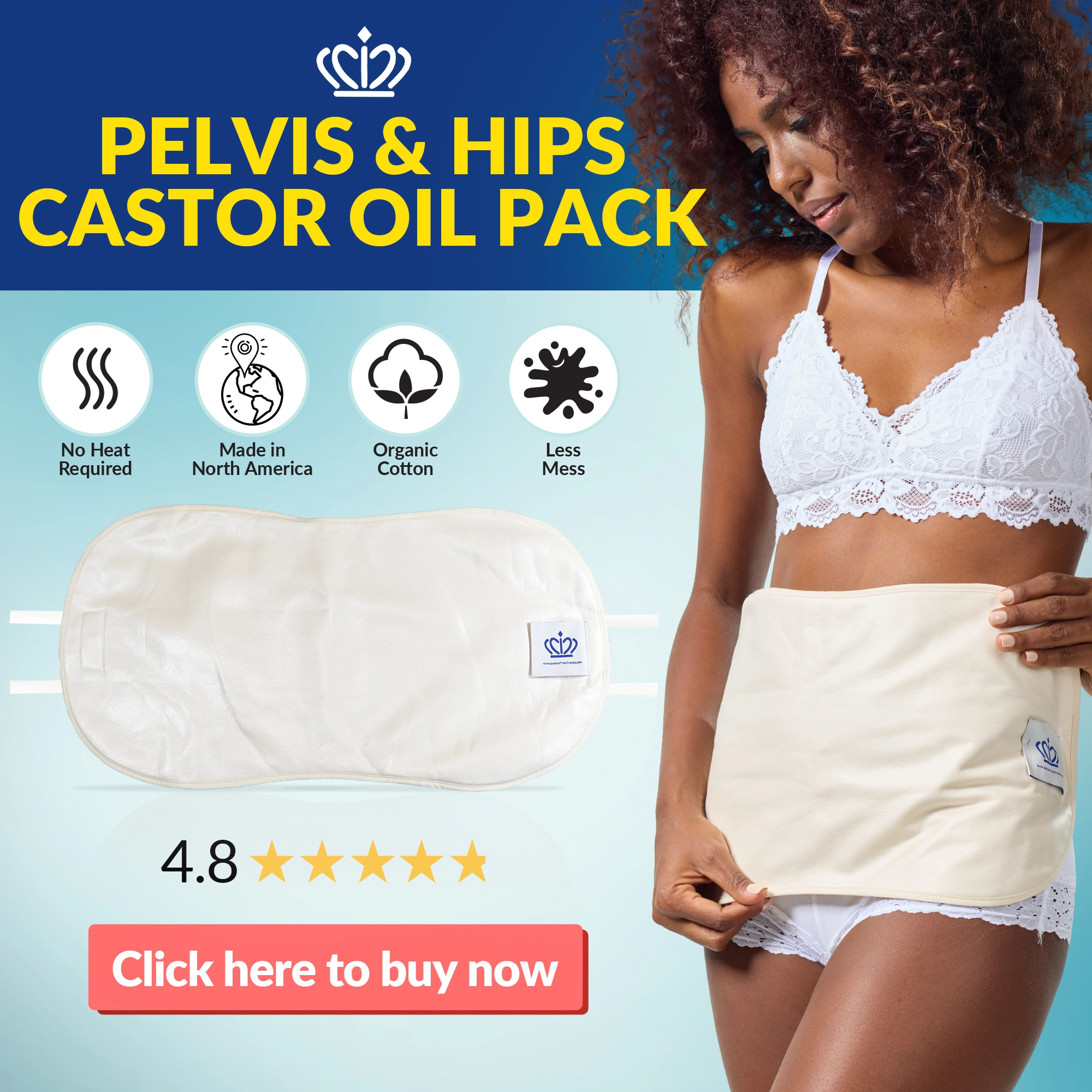
Moreover, the indulgent sensation of Castor Oil on your skin may contribute to supporting dopamine levels, potentially supporting a sense of satisfaction.20 In the context of managing endometriosis symptoms, this luxurious experience can be a comforting addition, offering relief and enhancing your well-being.
Sounds good, agreed? Get your Pelvis & Hips Castor Oil Pack Now!
Moreover, gluten also acts as a prebiotic, supporting the growth of “good” bacteria in your body. It can also help imbalance of bad and good bacteria associated with gut dysbiosis.
What about dairy?
Eating dairy products is the easiest way to get vitamin D, calcium, and proteins needed for the healthy heart, bones, and muscles.
It helps maintain bone density and reduces the risk of fractures.
Studies have even suggested that the right kind of dairy may prevent heart disease.3
So, why is there so much discussion about dairy-free foods?
Well, similar to gluten, your digestive system releases the enzyme lactase to digest sugar in dairy products called lactose.
If you have a problem producing lactase, you probably have symptoms of lactose intolerance, including stomach pain, diarrhea, bloating, and nausea. Makes sense, agreed?
Moreover, evidence suggests that dairy products may improve body composition by reducing waist circumference and fat composition.4
A review of 25 studies also found that various types of yogurt were linked to the lower risk of metabolic syndrome risk factors, such as obesity, high blood pressure, and type 2 diabetes.5
With this in mind, let’s understand more about gut glue.
What about dairy?
My best and favorite example of this is how glue is made.
White school glue, if you didn’t know, is actually edible. You can essentially make it at home with milk, flour, and baking soda, and then the ingredient that is the pièce de résistance is vinegar.
This combination is basically what happens in your belly, when you combine bread (flour) with cheese (dairy/milk) and you swallow it down into your stomach that contains your stomach acid (like vinegar, because it’s acidic!) and bicarbonate (like baking soda).6
Guess what, you’ve got glue in your belly!
So imagine what your gut is like, if you are consuming glue.
Let’s talk anatomy for a second. Ready?
Your small intestine is lined by finger-like projections called villi, that help you absorb nutrients from your food.
Gut glue could cause these projections to get stuck together and reduce your ability to properly digest your food!
In addition, because the carbohydrates and protein don’t digest well together, you get this glue moving all along your digestive tract.
All in all, it’s rarely only one thing that is causing discomfort. It is often multifactorial and there are many contributing factors and culprits.
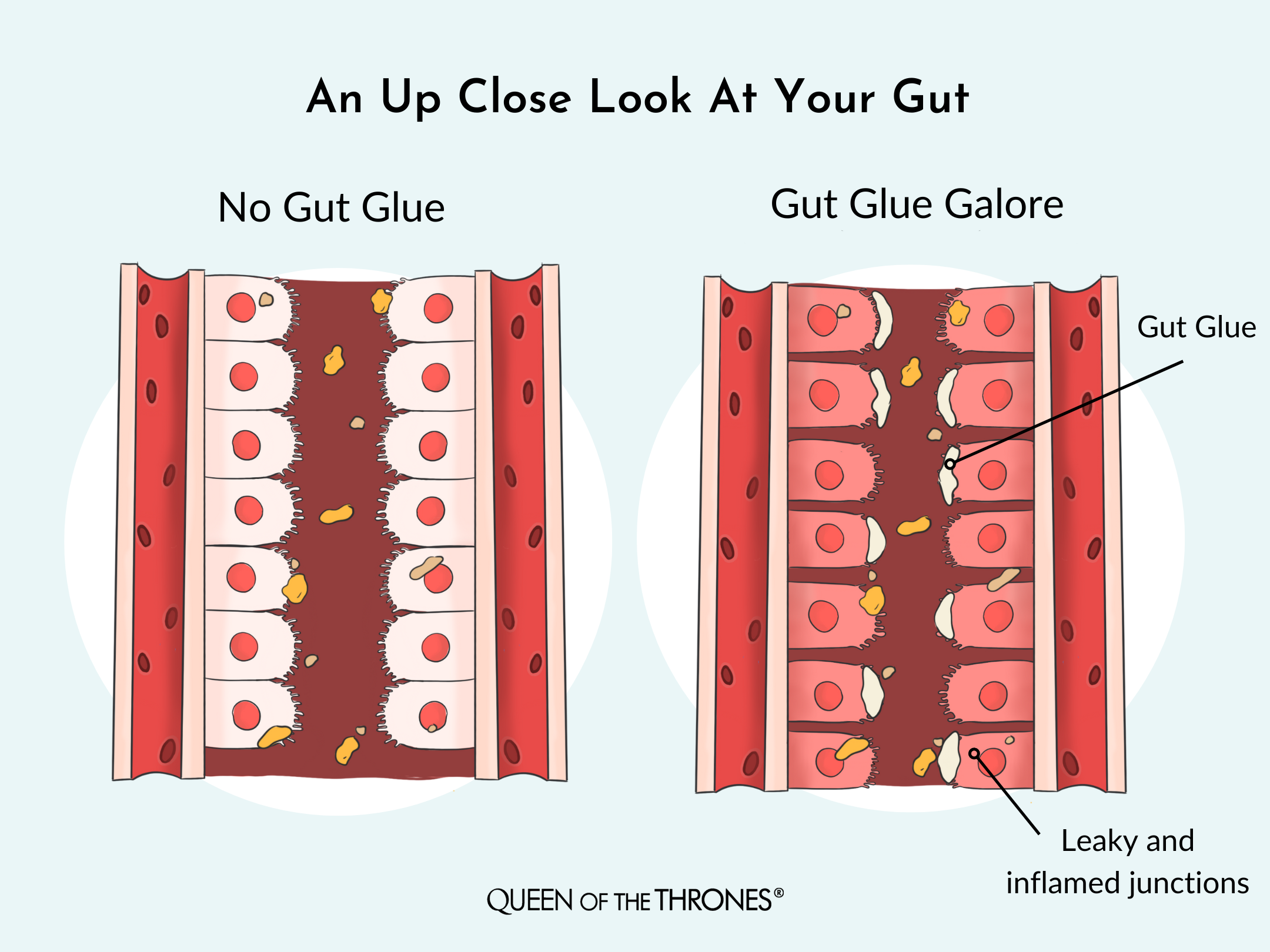
This is simply an example where combining gluten and dairy together may not be ideal for digestion (they also happen to be some of the most common food sensitivities and allergies that people deal with).
This is not it.
According to the traditional Ayurveda medicine, excessive amounts of proteins, carbohydrates and fats should not be taken together as this leads to a feeling of heaviness in the stomach.7
Plus, milk is considered as a complete food.
It contains antioxidants, vitamins, minerals, proteins, good fats, amino acids, calcium, vitamin D, magnesium, lactose, and all nutrients necessary for a healthy body.
That is why in Ayurveda it has been advised not to take wheat products with milk.
What can you do about your digestion problems?
When we choose nourishing food combinations, time our meals accordingly, and create healthy habits like proper chewing, we reduce the chances of these uncomfortable, and sometimes painful symptoms.
Plus, adding the practice of Queen of the Thrones® Castor Oil Packs after your meal may further help with inflammation regulation and help to improve liver detoxification, lymphatic drainage and colon cleansing, which means less digestive problems. Amazing, right?
Would you love to know how Castor Oil Packs work and how they can support your gut health?
Are you a practitioner, health coach or wellness influencer? If you’re interested in recommending our easy-to-use tools and practically applying them in your health and wellness professional practice, in clinic, or online with the people you serve, you can join now!
Click here for references
1. Cömert ED, Gökmen V. Effect of food combinations and their co-digestion on total antioxidant capacity under simulated gastrointestinal conditions. Curr Res Food Sci. 2022 Feb 17;5:414-422. doi: 10.1016/j.crfs.2022.02.008. PMID: 35243354; PMCID: PMC8866489.
2. Ye EQ, Chacko SA, Chou EL, Kugizaki M, Liu S. Greater whole-grain intake is associated with lower risk of type 2 diabetes, cardiovascular disease, and weight gain. J Nutr. 2012 Jul;142(7):1304-13. doi: 10.3945/jn.111.155325. Epub 2012 May 30. Erratum in: J Nutr. 2013 Sep;143(9):1524. PMID: 22649266; PMCID: PMC6498460.
3. Lordan R, Tsoupras A, Mitra B, Zabetakis I. Dairy Fats and Cardiovascular Disease: Do We Really Need to be Concerned? Foods. 2018 Mar 1;7(3):29. doi: 10.3390/foods7030029. PMID: 29494487; PMCID: PMC5867544.
4. Abargouei AS, Janghorbani M, Salehi-Marzijarani M, Esmaillzadeh A. Effect of dairy consumption on weight and body composition in adults: a systematic review and meta-analysis of randomized controlled clinical trials. Int J Obes (Lond). 2012 Dec;36(12):1485-93. doi: 10.1038/ijo.2011.269. Epub 2012 Jan 17. PMID: 22249225.
5. Khorraminezhad L, Rudkowska I. Effect of Yogurt Consumption on Metabolic Syndrome Risk Factors: a Narrative Review. Curr Nutr Rep. 2021 Mar;10(1):83-92. doi: 10.1007/s13668-020-00344-y. Epub 2021 Jan 6. PMID: 33405074.
6. G. Lynn Carlson. A New approach to the baking soda-vinegar reaction. J. Chem. Educ., 1990, 67 (7), p 597 DOI: 10.1021/ed067p597. Publication Date: July 1990
7. Sabnis M. Viruddha Ahara: A critical view. Ayu. 2012 Jul;33(3):332-6. doi: 10.4103/0974-8520.108817. PMID: 23723637; PMCID: PMC3665091.



0 Comments